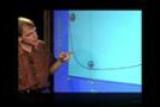Conceptual Physics
Chapter 34: Nuclear Fission and Fusion
Matter and Energy are Convertible
The relationship between mass and energy is discussed. The amount of energy found within a given mass is calculated using the famous equation E=mc2. Duration: 9:18.
A Nucleon's Mass Depends on Location
The mass of a nucleon depends upon where it is located. A nucleon in a uranium nucleus, for example, is more massive than it would be if it were in an iron nucleus. Duration: 3:15.
Watch these additional videos to complete this tutorial.
Table of Videos
- Chapter 1: About Science
- Chapter 2: Newton's First Law
- Chapter 3: Linear Motion
- Chapter 4: Newton's Second Law
- Chapter 5: Newton's Third Law
- Chapter 6: Momentum
- Chapter 7: Energy
- Chapter 8: Rotational Motion
- Chapter 9: Gravity
- Chapter 10: Projectile and Satellite Motion
- Chapter 11: The Atomic Nature of Matter
- Chapter 12: Solids
- Chapter 13: Liquids
- Chapter 14: Gases
- Chapter 15: Temp, Heat, and Expansion
- Chapter 16: Heat Transfer
- Chapter 17: Change of Phase
- Chapter 18: Thermodynamics
- Chapter 19: Vibrations and Waves
- Chapter 20: Sound
- Chapter 21: Musical Sounds
- Chapter 22: Electrostatics
- Chapter 23: Electric Current
- Chapter 24: Magnetism
- Chapter 25: Electromagnetic Induction
- Chapter 26: Properties of Light
- Chapter 27: Color
- Chapter 28: Reflection and Refraction
- Chapter 29: Light Waves
- Chapter 30: Light Emission
- Chapter 31: Light Quanta
- Chapter 32: The Atom and the Quantum
- Chapter 33: The Atomic Nucleus
- Chapter 34: Nuclear Fission and Fusion
- Chapter 35: Special Theory of Relativity
- Chapter 36: General Theory of Relativity


